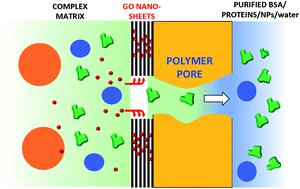当前位置:
X-MOL 学术
›
Faraday Discuss.
›
论文详情
Our official English website, www.x-mol.net, welcomes your
feedback! (Note: you will need to create a separate account there.)
Core–shell graphene oxide–polymer hollow fibers as water filters with enhanced performance and selectivity
Faraday Discussions ( IF 3.3 ) Pub Date : 2020-1-23 , DOI: 10.1039/c9fd00117d Alessandro Kovtun 1 , Antonio Bianchi , Massimo Zambianchi , Cristian Bettini , Franco Corticelli , Giampiero Ruani , Letizia Bocchi , Francesco Stante , Massimo Gazzano , Tainah Dorina Marforio , Matteo Calvaresi , Matteo Minelli , Maria Luisa Navacchia , Vincenzo Palermo , Manuela Melucci
Faraday Discussions ( IF 3.3 ) Pub Date : 2020-1-23 , DOI: 10.1039/c9fd00117d Alessandro Kovtun 1 , Antonio Bianchi , Massimo Zambianchi , Cristian Bettini , Franco Corticelli , Giampiero Ruani , Letizia Bocchi , Francesco Stante , Massimo Gazzano , Tainah Dorina Marforio , Matteo Calvaresi , Matteo Minelli , Maria Luisa Navacchia , Vincenzo Palermo , Manuela Melucci
Affiliation

|
Commercial hollow fiber filters for micro- and ultrafiltration are based on size exclusion and do not allow the removal of small molecules such as antibiotics. Here, we demonstrate that a graphene oxide (GO) layer can be firmly immobilized either inside or outside polyethersulfone–polyvinylpyrrolidone hollow fiber (Versatile PES®, hereafter PES) modules and that the resulting core–shell fibers inherits the microfiltration ability of the pristine PES fibers and the adsorption selectivity of GO. GO nanosheets were deposited on the fiber surface by filtration of a GO suspension through a PES cartridge (cut-off 0.1–0.2 μm), then fixed by thermal annealing at 80 °C, rendering the GO coating stably fixed and unsoluble. The filtration cut-off, retention selectivity and efficiency of the resulting inner and outer modified hollow fibers (HF-GO) were tested by performing filtration on water and bovine plasma spiked with bovine serum albumin (BSA, 66 kDa, ≈15 nm size), monodisperse polystyrene nanoparticles (52 nm and 303 nm sizes), with two quinolonic antibiotics (ciprofloxacin and ofloxacin) and rhodamine B (RhB). These tests showed that the microfiltration capability of PES was retained by HF-GO, and in addition the GO coating can capture the molecular contaminants while letting through BSA and smaller polystyrene nanoparticles. Combined XRD, molecular modelling and adsorption experiments show that the separation mechanism does not rely only on physical size exclusion, but involves intercalation of solute molecules between the GO layers.
中文翻译:

核-壳氧化石墨烯-聚合物空心纤维作为滤水器,具有增强的性能和选择性
用于微滤和超滤的商用中空纤维过滤器基于尺寸排阻,不允许去除诸如抗生素之类的小分子。在这里,我们证明了氧化石墨烯(GO)层可以牢固地固定在聚醚砜-聚乙烯吡咯烷酮中空纤维(VersatilePES®,以下简称PES)模块的内部或外部,并且所得的核-壳纤维继承了原始PES的微滤能力。纤维和GO的吸附选择性。通过使用PES滤芯过滤GO悬浮液(截止值为0.1–0.2μm),将GO纳米片沉积在纤维表面上,然后通过在80°C下进行热退火固定,从而使GO涂层稳定地固定且不溶。过滤截止,通过在水和掺有牛血清白蛋白(BSA,66 kDa,≈15nm尺寸),单分散聚苯乙烯纳米粒子的牛血浆中进行过滤,测试了所得内部和外部改性空心纤维(HF-GO)的保留选择性和效率纳米和303 nm大小),以及两种喹诺酮类抗生素(环丙沙星和氧氟沙星)和若丹明B(RhB)。这些测试表明,HF-GO保留了PES的微滤能力,此外,GO涂层可以捕获分子污染物,同时使其通过BSA和较小的聚苯乙烯纳米颗粒。结合XRD,分子建模和吸附实验表明,分离机理不仅取决于物理尺寸排阻,还涉及溶质分子在GO层之间的插入。
更新日期:2020-01-23
中文翻译:

核-壳氧化石墨烯-聚合物空心纤维作为滤水器,具有增强的性能和选择性
用于微滤和超滤的商用中空纤维过滤器基于尺寸排阻,不允许去除诸如抗生素之类的小分子。在这里,我们证明了氧化石墨烯(GO)层可以牢固地固定在聚醚砜-聚乙烯吡咯烷酮中空纤维(VersatilePES®,以下简称PES)模块的内部或外部,并且所得的核-壳纤维继承了原始PES的微滤能力。纤维和GO的吸附选择性。通过使用PES滤芯过滤GO悬浮液(截止值为0.1–0.2μm),将GO纳米片沉积在纤维表面上,然后通过在80°C下进行热退火固定,从而使GO涂层稳定地固定且不溶。过滤截止,通过在水和掺有牛血清白蛋白(BSA,66 kDa,≈15nm尺寸),单分散聚苯乙烯纳米粒子的牛血浆中进行过滤,测试了所得内部和外部改性空心纤维(HF-GO)的保留选择性和效率纳米和303 nm大小),以及两种喹诺酮类抗生素(环丙沙星和氧氟沙星)和若丹明B(RhB)。这些测试表明,HF-GO保留了PES的微滤能力,此外,GO涂层可以捕获分子污染物,同时使其通过BSA和较小的聚苯乙烯纳米颗粒。结合XRD,分子建模和吸附实验表明,分离机理不仅取决于物理尺寸排阻,还涉及溶质分子在GO层之间的插入。











































 京公网安备 11010802027423号
京公网安备 11010802027423号